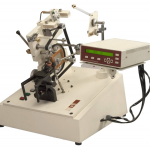In our recent series of articles, we delved into the various types of coil winding machines. Our last article focused on linear winding machines. This time, we will explore toroidal winding machines, another essential type of winding machine. Toroidal winding machines are specifically designed to wind inductors that consist of toroids or round rings. Unlike linear winding machines, toroidal winding machines are more complex and tailored to handle the unique process of winding toroids. Below, we provide a comprehensive explanation of toroidal winding machines.
Toroidal Winding Machine

A complete toroidal winding machine comprises three main units: the base, the roller table, and the head. Each unit plays a distinct and crucial role in the winding process.
- 1. Base: The base of the machine includes a flat bed that supports the motor mechanism. This motor mechanism is responsible for rotating the shuttle. Additionally, the base supports the other two units of the machine, ensuring stability and smooth operation. The operating switches are mounted on the head, making them easily accessible for the operator to perform the winding process.
- 2. Head: The head of the machine consists of various shafts that hold and rotate the shuttle or the magazine. The shuttle is used to hold the winding wire. Initially, the required amount of wire is loaded onto the shuttle. During the winding cycle, this wire is unwound from the shuttle and wound onto the core. Toroidal winding machines are further classified based on the type of head used. There are three different head designs available in the market:
- - Belt Type Head: Utilizes a belt mechanism to provide tension to the wire and unwind it from the shuttle to the core.
- - Slider Type Head: Features a small component called a slider, which moves along the circumference of the shuttle to unwind the wire and wind it onto the core.
- - Gear Type Head: Employs a gear mechanism to rotate the shuttle and transfer the wire from the shuttle to the core.
- 3. Roller Table: The roller table holds the core onto which the wire is wound. Its primary function is to rotate the core during the winding process. This ensures that the wire is evenly wound around the circumference of the core, preventing the wire from being wound onto the same position repeatedly.
Belt Type Toroidal Winding Machine:
Depending on the head design, toroidal winding machines can be further categorized into three types:
-
Belt Type Toroidal Winding Machine:
Uses a belt mechanism for tensioning and unwinding the wire.
-
Slider Type Toroidal Winding Machine:
Utilizes a slider to guide the wire from the shuttle to the core.
-
Gear Type Toroidal Winding Machine:
Implements a gear mechanism to rotate the shuttle and wind the wire onto the core.
Future Discussions
In future discussions, we will delve deeper into these three types of toroidal winding machines. Each type has its own set of advantages and applications, which we will explore in detail.
Acme Electronics
Acme Electronics offers both slider type and belt type winding machines. All functions are controlled by a microprocessor-based controller unit, simplifying the winding process and enhancing precision.
For a complete view of the winding cycle and additional details on our products, visit our website: Acme Electronics Toroidal Winding Machines.
Toroid winding machines are vital in the manufacturing of inductors and other electronic components. Understanding the different types and their specific applications can help you choose the right machine for your needs, ensuring efficiency and accuracy in your production process.

